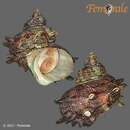Diagnostic Description
provided by FAO species catalogs
Shell large, thick, greenish grey with pronounce lamellate horns. Surface roughened by about 5 thick spiral ribs and secondary ribs; semitubular processes often formed in 2 rows or more. Growth lines finely lamellate, especially distinct between spiral ribs. Length and density of processes showing considerable variations by environmental conditions. It is spirally grooved in counterclockwise: surface covered by fine spines. The operculum (diameter < 3.5 cm) is either green or red brown and the surface is granular .
- Ai, T. -1965. Spawning and early development of the topshell Turbo cornutus Solander-II. Induction of spawning and larval development. Bull. Jap. Soc. Sci. Fish/Nissuishi. 31: 105-112.
- Chan, B.K. & R. Huang -2000. Diet and feeding preference of Turbo cornutus (Gastropoda:Turbinidae) in Hong Kong. The Marine Flora and Fauna of Hong Kong and Southern China V (ed. B. M orton). Hong Kong University press. 205-216 .
- Kojima, S., R. Segawa & I. Hayashi -1997. Genetic differentiation among populations of the Japanese turban shell Turbo (Batillus) cornutus corresponding to warm currents. Mar. Eciol. Prog. Ser. 150: 149-155 .
- Okabe, M, A. Kuwahara, M. Nishimura & M. Yoshida -1989. Marine ranching of the topshell, Batillus cornutus. Japan Fisheries Resource Conservation Associtaton, Tokyo.
- Okutani, T. -2000. Marine mollusks in Japan. edited by Takashi Okutani.1st ed.Tokyo :Tokai University Press, ISBN 4 486 01406 5. 1173p.
- Yamamoto, T & Yamakawa, H -1985. The gonadal maturation in Turbo (Batillus) cornutus. Bull. Jap. Soc. Sci. Fish/Nissuishi. 51: 357-364.
Size
provided by FAO species catalogs
Adults reach up to 14 cm in shell length.
Brief Summary
provided by FAO species catalogs
Intertidal up to 30 m in depth.Wide range of algae. Juveniles diet is dominated by red turf algae Gelidium pusillum and Polysiphonia spp. while the adults consume both these and the macroalgae Sargassum hemiphyllum and Padina spp.; Corallina spp. and encrusting brown algae are also ingested but in small quantities (Chan & Huang 2000). Histological observations have indicated that the ovary and testis ripen from May through September. The polygonal diagrams of egg size frequency increase in May and drop suddenly in September. The tendency in gonad indices is synchronous. The spawning is considered to occur in August and September (Yamamoto & Yamakawa, 1985). Lecithotrophic larvae with a short planktonic period of 3 to 5 days (Ai, 1965).

